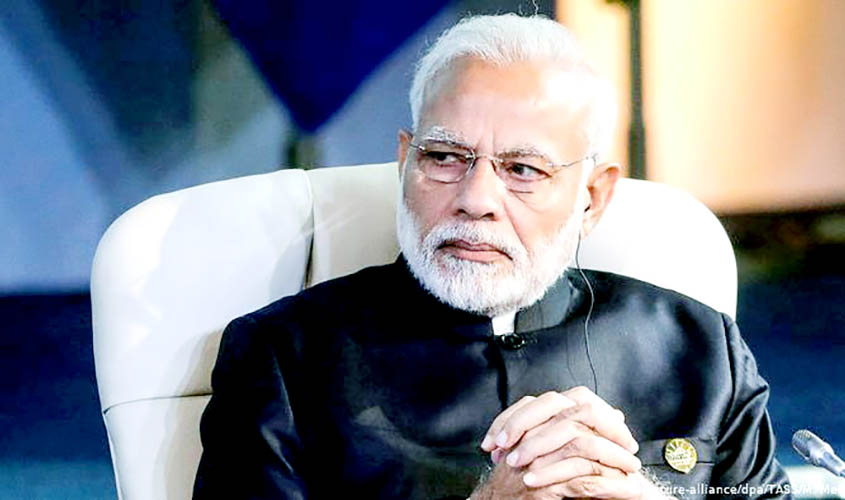Protests over the citizenship law have come at a time when India’s biggest leverage—its economy—is facing deceleration, bringing Narendra Modi and his government under scrutiny. Most proxy and leading indicators mirror that the gross domestic product (GDP) is estimated to grow at an 11-year low of 5%. Economists have been predicating this low ground during the past week. A World Bank study released on 9 January, while forecasting a deceleration to 5%, has estimated that India’s GDP will start moving up slowly and a 5.8% growth is likely by the end of next year.
In this backdrop Narendra Modi has been focusing on ways to steer the economy back to buoyancy. He has had over a dozen meetings in the past fortnight with small groups of industrialists and experts from the fields of agriculture, finance and services industry. Some of these meetings have even run for 11 hours. The most prominent of these were the ones he had with a dozen top industrialists on 6 January and the meeting at the Niti Aayog on Thursday. He told the top industrialists that the fulcrum of the economy was no longer restricted to the Bombay Club—alluding to the elite group formed by Mumbai industrialists in 1991 when reforms rolled in—but was being driven by what may be called the “Bharat Club”: a reference to the new class of entrepreneurs, especially start-ups, emerging in the country who are redefining markets, challenging the status quo and disrupting the existing ecosystem, demonstrating risk taking ability through innovation in technology and management practices. He said that if a Bharat Club is formed today it will have representatives of different sectors—old veterans and new entrepreneurs—represented in it.
Simultaneously, Finance Minister Nirmala Sitharaman has been holding her customary pre-Budget consultations, both within the government and with the industry, and seeking inputs from her party colleagues. On 9 January, while the Prime Minister and other senior ministers, including Amit Shah, Nitin Gadkari and Piyush Goyal were at the Niti Aayog, Sitharaman was meeting BJP leaders. Her absence from the Prime Minister’s meetings has raised some eyebrows, with Congress spokespersons taking pot-shots at the government. It is perhaps for the first time that a Prime Minister is taking an obtrusive role in pre-Budget parlays and the 2020-21 Budget on 1 February may see dramatic announcements including changes in income tax rates and slabs to enable more money in the hands of consumers and thence trigger a consumption driven growth.
A silent revolution in the form of Direct Benefit Transfers has taken place, reaching money to the beneficiaries, thereby perhaps addressing Rajiv Gandhis’s lament three decades back that only a minuscule portion of the benefits released by the government reach the rightful people. DBT has been praised by the World Bank study of 9 January. Nobel Laureate Abhijit Banerjee, while addressing a media event, labelled Modi’s economics as “Left of Centre” and said the Prime Minister’s emotional heart has been at transfer schemes (this while he was perhaps otherwise critical of recent developments in the country).
While DBT has ushered probity, other decisions of Modi, harnessing technology, like abolition of direct interface with income tax officials through online assessments have given relief and provided impetus for compliance. The Goods & Services Tax, which kicked in at a grand midnight event in the Central Hall of Parliament on 1 July 2017 (to ensure that the scheme’s patriarch, Pranab Mukherjee, presided over its introduction on the eve of his demitting the office of President of India) has also given fillip to transparency, though hiccups remain three years on. The number of businesses registered with indirect taxation system in these three years has risen from 7.6 million to 13 million—an indication of the plugging of leakage and enforcement of the rule of law. The Insolvency and Bankruptcy Code (IBC) and measures for promoting the ease of doing business (new business can now be registered in five days’ time) have changed the paradigm. These undercurrents will go a long way in ushering in a “Bharat Club” template.
In his meetings with ministries in the past month, Modi has sought a five-year vision for growth—each plan has been reviewed in detail and ministers and secretaries were subjected to thorough scrutiny. Those associated with the exercise say that the forthcoming Union Budget may be a reset moment of sorts for the economy.
Labour reforms are on the anvil. The Industrial Relations Bill, introduced in the Lok Sabha, is now before a Standing Committee in Parliament and its adoption may be one of the highlights of 2020. Streamlining of commercial courts system is another reform being awaited. If commercial courts are adequately resourced at the district level the ease of doing business will be strengthened.
Privatisation of airports; allowing private players in running of railway passenger trains; changes in city gas distribution; streamlining LPG supply and focus on infrastructure development coupled with privatization of public sector undertakings are other big ticket agendas ahead. The restructuring of the Railway Board and corporatisation of the Ordnance Factory Board are much awaited reforms which are underway. (Railways and Ordnance Factories are the top two employers in the government sector and the largest in the economy.) The very fact that Air India disinvestment is being overseen by a committee headed by Amit Shah is an indication of the government’s intent.
In the midst of gloom a news from Chandigarh, published by the Tribune, gives a glimpse of the Bharat Club: industrialist Anand Mahindra has named 94-year-old Harbhajan Kaur as his choice for “entrepreneur of the year”—she runs a startup which sells besan barfi, which has become a popular consumer item in that city. Not only millennials of US Silicon Valley and Bengaluru, even old ladies of Punjab seem to have been inspired by Modi’s Startup India mission. Apparently, things are not what they seem.

